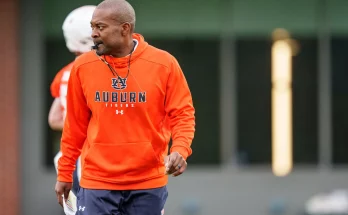Mark Ingram’s Crimson Heart Beats Stronger Than Ever as He Returns to Tuscaloosa to Help Carry the Tide Forward
Mark Ingram is back in Tuscaloosa—not with cleats laced or helmet strapped, but with his heart fully invested in the same Alabama Crimson Tide program that helped shape his legendary career. Years after making history as the first Alabama player to win the Heisman Trophy, Ingram returns to where it all began. This time, he’s not here to score touchdowns but to mentor, inspire, and push the next generation of champions. Ingram’s Crimson heart, still pounding with the same intensity that made him a fan favorite, now beats with a new purpose: to help lead Alabama into its next golden era.
When Ingram first arrived in Tuscaloosa in 2008, the program was rebuilding under a relatively new head coach named Nick Saban. Fast forward to today, and Alabama has since transformed into the gold standard of college football. Ingram was a catalyst for that transformation, and now he’s determined to be a cornerstone of its continued dominance. Returning as a key ambassador and advisor for the football program, Ingram brings not just credibility, but the kind of infectious energy and passion that only a true believer in Crimson can exude.
It’s rare to see a Heisman winner return to his alma mater in such a meaningful capacity. Many move on to NFL careers and never look back. But Ingram is built differently. After a successful NFL career spanning over a decade, including three Pro Bowl selections and nearly 10,000 total yards, he remains tied to the program that first made him a star. For Ingram, Tuscaloosa isn’t just where his football journey began—it’s where he became a man. It’s where values like grit, loyalty, and discipline were instilled in him. And now, with his cleats hung up, he’s here to pass those lessons on.
Walking through the hallways of the Mal M. Moore Athletic Facility today, Ingram doesn’t look like a retired athlete seeking nostalgia. He looks like a man on a mission. The current players feel it. Coaches feel it. Fans feel it. There’s a gravity when Mark Ingram speaks. He’s not just another former player dropping in; he’s a living legend, someone who understands what it means to wear the Crimson jersey and the pressure, pride, and power that comes with it. When he talks about the “Bama standard,” it doesn’t sound like rhetoric—it sounds like gospel.
Ingram’s return also comes at a time of transition for Alabama. With Coach Saban’s era having concluded and a new leadership chapter beginning, stability and culture matter more than ever. Ingram provides both. He’s not just a bridge to the past—he’s a beacon for the future. His perspective is unique: he knows what it’s like to struggle for playing time as a freshman, to explode into stardom as a sophomore, and to carry the weight of a program on his back. That experience makes him invaluable to young players navigating the high expectations that come with playing for Alabama.
Whether he’s in the weight room, watching practice from the sidelines, or speaking to players in closed-door sessions, Ingram’s presence is always purposeful. He’s not here for photo ops. He’s here to mentor. He’s here to challenge. And most importantly, he’s here to remind these young athletes of the privilege and responsibility that comes with being part of the Alabama football brotherhood.
One of the defining features of Ingram’s legacy is his relentless work ethic. It’s something he learned and perfected under Coach Saban, and now he’s passing that same ethos down. He tells players that talent gets you recruited, but effort, discipline, and mental toughness win championships. It’s not just talk. He lived it. His 2009 season remains etched in Alabama lore—not just because of the 1,658 rushing yards or the 17 touchdowns, but because of the way he carried himself: with humility, toughness, and a warrior’s spirit.
Ingram’s role with the program is multifaceted. He’s helping with player development, alumni engagement, and public relations, but perhaps his most valuable contribution is cultural. Programs rise and fall not just on talent, but on identity. Ingram embodies what it means to be Alabama. He understands that playing for the Tide isn’t just about football; it’s about upholding a tradition. He reminds players that they’re part of something bigger than themselves—a legacy forged in sweat, sacrifice, and glory.
When asked why he chose to return, Ingram’s answer is simple yet powerful: “Because this place gave me everything.” That humility, even after all he’s achieved, is what sets him apart. It’s also why his message resonates so deeply with the team. In an era of NIL deals, transfer portals, and shifting loyalties, Ingram is a symbol of unwavering commitment. He didn’t just leave with trophies—he left with a deep sense of gratitude. And now he’s giving back in the most meaningful way he knows how.
It’s not just the players who benefit from his return. Fans, too, are energized by seeing one of their heroes back on campus. Ingram has always had a magnetic personality, and now that charisma is being channeled into service. He attends booster events, speaks at alumni functions, and engages with the community with the same passion he brought to the field. For Alabama fans, Ingram is more than a former player—he’s a standard bearer, a reminder of what’s possible when talent meets character.
Ingram’s return also sends a powerful message to recruits: Alabama isn’t just a stepping stone to the NFL—it’s a lifelong family. When recruits meet Ingram, they don’t just see a pro athlete; they see a mentor, a champion, a brother. His presence reinforces the idea that Alabama invests in its people long after the final whistle blows. That kind of message can’t be manufactured—it has to be lived. And Ingram is living proof.
What’s perhaps most impressive is how seamlessly Ingram has transitioned into this new role. He’s no longer running through defensive lines, but he’s still breaking barriers—this time, by redefining what leadership looks like after the game. For young athletes watching his journey, the lesson is clear: greatness doesn’t end when the cleats come off. In many ways, it’s just beginning.
As Alabama gears up for another title run, having Mark Ingram around feels like a secret weapon. He may not be taking handoffs anymore, but his fingerprints are already all over this team’s mentality. He’s there in the locker room talks, the early morning lifts, the game day huddles. His influence is subtle but powerful—a steady heartbeat that reminds everyone of what Alabama stands for.
If the Crimson Tide hoists another national championship trophy in the near future, don’t be surprised if Ingram is standing nearby, smiling with pride—not because he touched the ball, but because he touched the hearts and minds of the players who did. Ingram’s legacy is no longer just about yards gained or awards won. It’s about lives changed, standards upheld, and traditions continued.
Mark Ingram came back to Tuscaloosa not to relive his glory days, but to create new ones—for others. His Crimson heart, forged in fire and success, now fuels a deeper mission. He’s not just helping carry the Tide. He is the Tide. And as long as his heart beats for Alabama, the future of the program looks as bright as ever.



